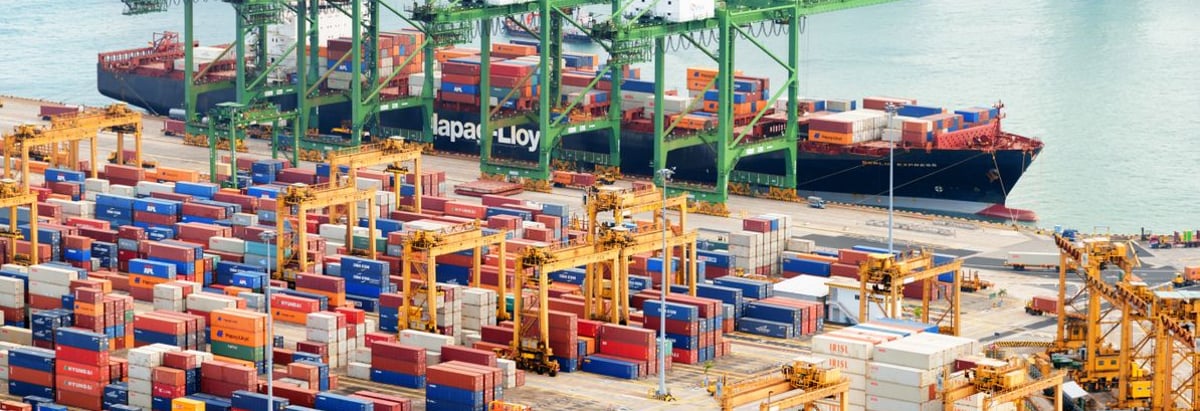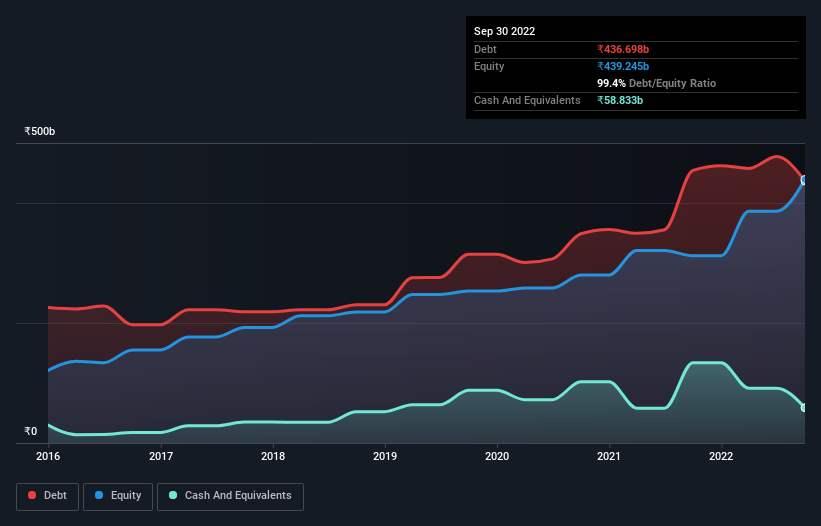- India
- /
- Infrastructure
- /
- NSEI:ADANIPORTS
Here's Why Adani Ports and Special Economic Zone (NSE:ADANIPORTS) Can Manage Its Debt Responsibly

Legendary fund manager Li Lu (who Charlie Munger backed) once said, 'The biggest investment risk is not the volatility of prices, but whether you will suffer a permanent loss of capital.' So it might be obvious that you need to consider debt, when you think about how risky any given stock is, because too much debt can sink a company. We note that Adani Ports and Special Economic Zone Limited (NSE:ADANIPORTS) does have debt on its balance sheet. But the more important question is: how much risk is that debt creating?
When Is Debt Dangerous?
Generally speaking, debt only becomes a real problem when a company can't easily pay it off, either by raising capital or with its own cash flow. If things get really bad, the lenders can take control of the business. While that is not too common, we often do see indebted companies permanently diluting shareholders because lenders force them to raise capital at a distressed price. Having said that, the most common situation is where a company manages its debt reasonably well - and to its own advantage. The first thing to do when considering how much debt a business uses is to look at its cash and debt together.
See our latest analysis for Adani Ports and Special Economic Zone
What Is Adani Ports and Special Economic Zone's Net Debt?
The chart below, which you can click on for greater detail, shows that Adani Ports and Special Economic Zone had ₹436.7b in debt in September 2022; about the same as the year before. On the flip side, it has ₹58.8b in cash leading to net debt of about ₹377.9b.

How Strong Is Adani Ports and Special Economic Zone's Balance Sheet?
The latest balance sheet data shows that Adani Ports and Special Economic Zone had liabilities of ₹90.2b due within a year, and liabilities of ₹469.1b falling due after that. Offsetting these obligations, it had cash of ₹58.8b as well as receivables valued at ₹45.8b due within 12 months. So its liabilities outweigh the sum of its cash and (near-term) receivables by ₹454.6b.
While this might seem like a lot, it is not so bad since Adani Ports and Special Economic Zone has a huge market capitalization of ₹1.91t, and so it could probably strengthen its balance sheet by raising capital if it needed to. But we definitely want to keep our eyes open to indications that its debt is bringing too much risk.
In order to size up a company's debt relative to its earnings, we calculate its net debt divided by its earnings before interest, tax, depreciation, and amortization (EBITDA) and its earnings before interest and tax (EBIT) divided by its interest expense (its interest cover). This way, we consider both the absolute quantum of the debt, as well as the interest rates paid on it.
Adani Ports and Special Economic Zone's net debt is 3.4 times its EBITDA, which is a significant but still reasonable amount of leverage. However, its interest coverage of 12.1 is very high, suggesting that the interest expense on the debt is currently quite low. One way Adani Ports and Special Economic Zone could vanquish its debt would be if it stops borrowing more but continues to grow EBIT at around 17%, as it did over the last year. The balance sheet is clearly the area to focus on when you are analysing debt. But it is future earnings, more than anything, that will determine Adani Ports and Special Economic Zone's ability to maintain a healthy balance sheet going forward. So if you want to see what the professionals think, you might find this free report on analyst profit forecasts to be interesting.
Finally, a business needs free cash flow to pay off debt; accounting profits just don't cut it. So the logical step is to look at the proportion of that EBIT that is matched by actual free cash flow. During the last three years, Adani Ports and Special Economic Zone produced sturdy free cash flow equating to 74% of its EBIT, about what we'd expect. This cold hard cash means it can reduce its debt when it wants to.
Our View
The good news is that Adani Ports and Special Economic Zone's demonstrated ability to cover its interest expense with its EBIT delights us like a fluffy puppy does a toddler. But truth be told we feel its net debt to EBITDA does undermine this impression a bit. It's also worth noting that Adani Ports and Special Economic Zone is in the Infrastructure industry, which is often considered to be quite defensive. Zooming out, Adani Ports and Special Economic Zone seems to use debt quite reasonably; and that gets the nod from us. While debt does bring risk, when used wisely it can also bring a higher return on equity. There's no doubt that we learn most about debt from the balance sheet. However, not all investment risk resides within the balance sheet - far from it. Case in point: We've spotted 3 warning signs for Adani Ports and Special Economic Zone you should be aware of.
When all is said and done, sometimes its easier to focus on companies that don't even need debt. Readers can access a list of growth stocks with zero net debt 100% free, right now.
New: Manage All Your Stock Portfolios in One Place
We've created the ultimate portfolio companion for stock investors, and it's free.
• Connect an unlimited number of Portfolios and see your total in one currency
• Be alerted to new Warning Signs or Risks via email or mobile
• Track the Fair Value of your stocks
Have feedback on this article? Concerned about the content? Get in touch with us directly. Alternatively, email editorial-team (at) simplywallst.com.
This article by Simply Wall St is general in nature. We provide commentary based on historical data and analyst forecasts only using an unbiased methodology and our articles are not intended to be financial advice. It does not constitute a recommendation to buy or sell any stock, and does not take account of your objectives, or your financial situation. We aim to bring you long-term focused analysis driven by fundamental data. Note that our analysis may not factor in the latest price-sensitive company announcements or qualitative material. Simply Wall St has no position in any stocks mentioned.
About NSEI:ADANIPORTS
Adani Ports and Special Economic Zone
Operates and maintains port infrastructure facilities in India.
Solid track record average dividend payer.
Similar Companies
Market Insights
Community Narratives




